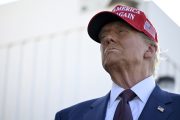
Just one week after James Bullard of the St. Louis branch of the Federal Reserve Bank released a paper declaring that “the U.S. is closer to a Japanese-style outcome today than at any time in recent history” (meaning that the United States will likely have decades of economic stagnation, which Bullard blames on "deflation"), the news media has taken up a chorus against the bogeyman of “deflation” to explain the need for further social spending by the government and more debasement of the U.S. dollar (causing consumer prices to rise through inflation).
The Japanese economy has experienced minimal economic growth since the 1980s, despite regular “stimulus” by increased government spending and borrowing. Once a manufacturing giant, the service sector of the Japanese economy now makes up three-quarters of its economy, and much of Japan’s manufacturing base has been "outsourced" to Korea, China and elsewhere in East Asia.
“The terrible trap of deflation gripped Japan for nearly fifteen years after its financial collapse in 1989,” Bullard noted. “Japan’s economy struggled to restart, but repeatedly fell back into recession. That is one definition of Depression — an economy that cannot get out of the ditch.” How bad is it? Per capita Japanese income has shrunk compared with U.S. per capita income by nearly half since 1995. Imagine losing nearly half of your current purchasing power.
Bullard claimed in his research paper that “it is conceivable to think that deflation could hurt the financial system and hamper US growth,” noting that Japan has suffered two full decades of recession that happened to coincide with some slight consumer price deflation over the same time period.
Media outlets such as National Public Radio, the Wall Street Journal, and various wire services have contributed to the deflation alarmism, warning ignorantly that deflation necessarily means a terrible recession. Of course, the entire 19th century of American history — one of unparalleled economic growth — was deflationary (at least in the sense that it involved lower prices for consumer goods). Prices for goods fell by almost half between 1800 and the initiation of the Federal Reserve Bank in 1913. And despite the deflationary century, no recession lasted more than four years during that time period.
What particularly worries Bullard is that the Federal Reserve Bank has cut the rate at the discount window (the so-called “Federal Rate”) to nearly zero for more than two years now, something that has never been done in U.S. history but that the Japanese used frequently during its two-decade-long recession. Bullard concludes that “the conventional wisdom is that Japan has suffered through a ‘lost decade’ partially attributable to the fact that the economy has been stuck in the deflationary, low nominal interest rate…. To the extent that is true, the U.S. and Europe can hardly afford to join Japan in the quagmire.” In a nutshell, Bullard believes that the Federal Reserve’s near-zero lending rates lead to deflation, and deflation destroys economic growth.
It’s a false post hoc ergo propter hoc argument to claim that deflation created the Japanese depression. To begin with, suppressing interest rates to below market rates (as the Federal Reserve has done) is inflationary rather than deflationary (it increases the amount of currency in circulation by encouraging borrowing and spending). It can lead to suppression of consumer prices by creating economic stagnation and the resulting consumer bargain-hunting. An economy focused upon borrowing and consumption is one not focused upon savings and investment, the important factors needed for economic growth.
But Bullard sees a cause-and-effect relationship between protracted suppression of interest rates and deflation, and therefore concludes that the Federal Reserve should only suppress interest rates to about two percent over a long period of time rather than to the current rate of zero that Federal Reserve officials have pegged: “Some of the current policy discussion has mulled an approach of this type, although not exactly in this context. The FOMC’s near-zero interest rate policy and the associated ‘extended period’ language has caused many to worry that the Committee is fostering the creation of new, bubble-like phenomena in the economy which will eventually prove to be counterproductive. One antidote to this worry may be to increase the policy rate somewhat, while still keeping the rate at a historically low level, and then to pause at that level.”
Bullard also recommended that the Federal Reserve Bank go big with inflation to stem the supposed pox of deflation, suggesting that “a better policy response to a negative shock is to expand the quantitative easing program through the purchase of Treasury securities.” By “quantitative easing,” Bullard means that the United States government would float new debt and then have the Federal Reserve buy the debt, effectively increasing the amount of currency in circulation and pushing inflation (and consumer prices) upward. “The quantitative easing program, to the extent it involves buying longer-dated government debt, has often been described as ‘monetizing the debt.’ This is widely considered to be inflationary, and so inflation expectations are sensitive to such purchases.”
Ironically, Bullard’s monograph for the St. Louis Federal Reserve launches a stinging attack upon the Obama administration’s borrow-and-spend strategy for getting out of the recession, noting that this was precisely the same tactic used by the Japanese after their economic bubble burst in 1989:
The proposal might work in a model setting, but the practicalities of getting a government to essentially threaten insolvency and be believed seem to rely far too heavily on the rational expectations of the private sector. Furthermore, governments that attempt such a policy in reality are surely playing with fire. The history of economic performance for nations actually teetering on the brink of insolvency is terrible. This does not seem like a good tool to use to combat the possibility of a low nominal interest rate steady state.
Beyond these considerations, it is questionable at this point whether such a policy actually works. Japan, our leading example in this story, has in fact embarked on an aggressive fiscal expansion, and the debt-to-GDP ratio there is now approaching 200 percent. Still, there does not appear to be any sign that the economy is about to leave the low nominal interest rate steady state, and now policymakers are worried enough about the international reaction to their situation that ?fiscal retrenchment is being seriously debated.
This flatly contradicts not only the current White House policy, but also the policy embraced by numerous leftist columnists, who argue that the United States must solve its current debt crisis by aggressively taking on more debt. For example, William Greider argued on NPR.com:
Forget the stupid deficit scare-mongering. Government must embrace more aggressive fiscal measures — bigger deficits, not little bitty gestures. New stimulus spending is needed to fight off the downward pressures. That, of course, will require the president to acknowledge what he now denies. The nation is not out of the danger zone. The government must act because it is the only sector in the economy that can lead the way.
Likewise, Robert Kuttner of the American Prospect argued on the Huffington Post Sunday that “the appeal of austerity is fading.”
Greider and Kuttner essentially argue that the United States should follow the example of Japan. The Japanese government has argued for two decades now that it is the only economic actor that can lead the nation out of recession by borrowing and spending. And Japan is now second in the world only to Zimbabwe in debt-to-GDP ratio with some 190 percent of GDP in national debt (the United States has increased from about 30 percent debt-to-GDP ratio in 1980 to nearly 100 percent today). Yet, the Japanese economy remains mired in recession.
While Bullard’s monograph offered this one important condemnation of Obama’s fiscal policy (a fiscal policy mirrored by the Republican minority on an only slightly smaller scale), for federal officials to follow Bullard’s advice the nation will nevertheless remain mired in recession. The only solution for our economic woes is to let the markets decide interest rates (and they would rise sharply) and to cut government spending under a balanced budget. But federal officials seem set against this policy for the time being.



